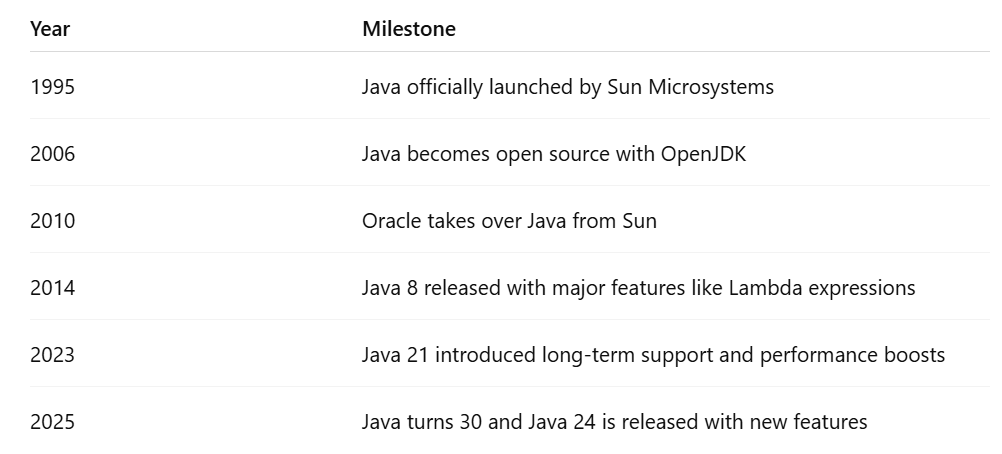🎓 Top 15 Udemy Courses (80-90% Discount): My Udemy Courses - Ramesh Fadatare — All my Udemy courses are real-time and project oriented courses.
▶️ Subscribe to My YouTube Channel (178K+ subscribers): Java Guides on YouTube
▶️ For AI, ChatGPT, Web, Tech, and Generative AI, subscribe to another channel: Ramesh Fadatare on YouTube
On May 23, 2025, Java celebrates its 30th birthday! That’s a huge milestone for one of the most popular and powerful programming languages in the world.
Java has been helping developers build software for everything from mobile apps to large-scale business systems since 1995. Over the past three decades, it’s grown, changed, and improved — but it’s never lost its place as a trusted tool in the developer world.
Let’s take a look at where Java came from, what’s happening today, and where it’s going in the future.
☕ Where Java Came From
Java started way back in 1991 as a small project called the “Green Project.” A team at Sun Microsystems, led by James Gosling, wanted to create a simple language for small devices like set-top boxes (used for TVs).
That idea didn’t take off, but the language they created — first called “Oak,” then renamed to Java — was officially released on May 23, 1995.
Its biggest selling point?
“Write Once, Run Anywhere.”
This meant you could write your code once, and it would run on any device that had the Java Virtual Machine (JVM). That was a game-changer.
🎉 Celebrating Java’s 30th Birthday — Livestream for Everyone
On May 22, 2025, there was also a big online event streamed on the Java YouTube channel.
People from all over the world joined to celebrate. Some of the speakers included:
- James Gosling (the creator of Java)
- Brian Goetz and Mark Reinhold (key people in Java’s development)
- Community leaders like Venkat Subramaniam and Nicolai Parlog
They talked about Java’s past, shared fun stories, and discussed what’s next for the language.
Java’s Global Impact
Java has left its mark on almost every area of technology:
💼 Enterprise Systems
- Java EE and now Jakarta EE dominate enterprise development
- Used in banking, insurance, healthcare, and government systems
- Frameworks like Spring Boot make it easy to build microservices
📱 Android
- Java was the official language of Android for years
- Millions of apps were built using Java before Kotlin took the lead
☁️ Cloud and Big Data
- Tools like Apache Kafka, Hadoop, Spark — all written in Java or use Java APIs
- Java plays a major role in modern cloud-native and event-driven architectures
🧪 Education
- Many universities use Java to teach programming and OOP concepts
- Its clear syntax and strong typing make it beginner-friendly but scalable
🔓 Open Source and Free
- Java is available as OpenJDK, which means it’s free to use and anyone can contribute to its development. This keeps the language fresh and up to date.
Why Java Still Matters Today
Here’s why Java is still relevant after 30 years:
✅ 1. Backward Compatibility
Apps written 10–15 years ago still run today with little or no change — and that’s a big deal in enterprise systems.
✅ 2. Mature Ecosystem
From IDEs like IntelliJ and Eclipse to libraries and frameworks like Spring, Java has tools for almost everything.
✅ 3. Strong Community
Millions of developers, thousands of Stack Overflow answers, and dozens of open-source projects — Java has one of the biggest and most supportive programming communities.
✅ 4. Great Performance
Modern JVMs are incredibly optimized. With features like JIT compilation, GC tuning, and now virtual threads, Java performs well even under heavy loads.
✅ 5. Polyglot Platform
The JVM runs other languages like Kotlin, Scala, Groovy, and Clojure — making Java a gateway to a whole ecosystem.
Java’s Global Community
Java has one of the largest developer communities in the world. That means:
- Tons of helpful resources for beginners
- Active forums and discussion groups
- Conferences, meetups, and online events
- Open-source tools and libraries shared by other developers
To make Java even easier to learn, Oracle created Learn.Java — a new site for students and teachers. It includes a Java Playground where you can run Java code right in your web browser. No setup needed!
What’s Next for Java?
Even though Java is 30 years old, it’s still improving all the time. Here’s what’s coming:
- Faster performance with smarter compilers and memory use
- Easier multi-threading using virtual threads, which help run many tasks at once
- Tools for building secure apps that work with new types of encryption
- More features that help Java work better with AI and machine learning
The Java team is focused on keeping the language modern, while still staying true to what made it great in the first place.
🙌 Thank You, Java
Millions of developers have built their careers on Java. It has helped power websites, mobile apps, business tools, and even games. It’s a language that’s easy to learn, but powerful enough for serious work.
So, whether you’re new to programming or have been coding for years, Java is still a great choice.
Here’s to 30 amazing years of Java — and to many more!
Quick Timeline: 30 Years of Java

Final Thoughts
Java’s 30th birthday isn’t just about looking back — it’s about seeing how far the language has come and how strong its future looks.
If you’re just starting to learn programming, Java is a great place to begin. It has clear rules, lots of learning resources, and a big community ready to help.
And if you’re already a Java developer? There’s never been a better time to keep learning and exploring what Java can do.
🎂 Happy 30th Birthday, Java! 🎉




![[NEW] Full-Stack Java Development with Spring Boot 4 & React Build 5 Spring Boot Projects with Java: Line-by-Line Coding](https://img-c.udemycdn.com/course/750x422/5338984_4d3a_5.jpg)










Comments
Post a Comment
Leave Comment